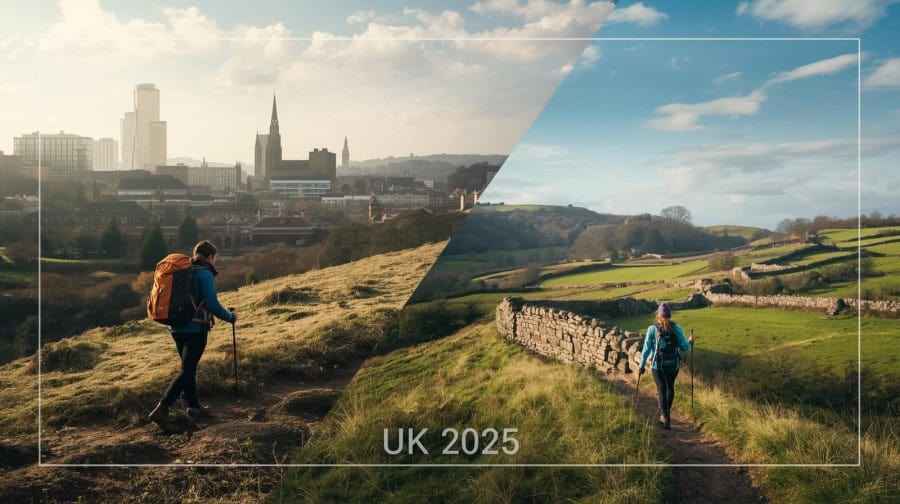Table of Contents
Some links on posts are affiliate links and will earn us a commission from qualifying purchases
Hiking in the UK is more popular than ever in 2025. People are heading outdoors in record numbers, not only to the mountains and national parks but also into their own towns and cities. Rural hiking still offers the classic big landscape experience that the UK is famous for, but urban hiking is growing fast because it is convenient, local and much easier for many people to access.
Both styles of walking have their own benefits and challenges. This guide looks at how they compare and how the gap between town and countryside walking is starting to narrow.
Rural Hiking: The Classic UK Adventure
For many people, rural hiking is what they imagine when they hear the word hiking. Think sweeping views, rugged hills and long-distance trails that run for miles across open countryside. Areas like the Lake District, Snowdonia and the Scottish Highlands remain the dream destinations for walkers who want challenge, solitude and a real sense of escape.
Rural hiking is supported by a huge network of footpaths, bridleways and national trails. Public transport links have improved in many areas, making it easier to reach remote trailheads without a car. Multi-day hikes are still a big draw and many people plan long weekends around routes like the Coast to Coast or the Pennine Way.
The motivations for rural hiking often focus on scenery and achievement. Walkers enjoy the physical test, the fresh air and the feeling of being far from everyday life.
Urban Hiking: The Fast Growing Choice
Urban hiking, sometimes called urban rambling, is becoming a major trend across the UK. Cities like London, Manchester and Birmingham now offer extensive walking networks that link parks, canals, heritage areas and quiet backstreets.
One of the biggest drivers of growth is the Slow Ways project. It has mapped around 10,000 walking and wheeling routes that aim to connect every town and city to each other and to surrounding countryside. This means people can now walk more easily from urban centres to rural areas without needing specialist knowledge.
Urban hiking appeals to people who want flexible, no-fuss walking. You can set off from your front door, pick a route that suits the time you have and enjoy both nature and culture along the way. It is an especially good starting point for newer hikers or anyone who does not have access to a car.
How Urban and Rural Hiking Compare
Here is a simple comparison table that shows how the two styles of walking differ in experience and accessibility.
| Feature | Rural Hiking | Urban Hiking |
|---|---|---|
| Typical Scenery | Hills, mountains, moorland, coastline | Parks, canals, rivers, heritage streets |
| Accessibility | Often requires transport and more planning | Walkable from home for many people |
| Challenge Level | Higher with more elevation and exposure | Lower with gentler terrain |
| Atmosphere | Quiet, remote, nature focused | Social, cultural, varied |
| Who It Suits | Adventure seekers, experienced hikers, weekend walkers | Beginners, time poor walkers, people without a car |
| Main Benefits | Big views, sense of escape, achievement | Convenience, inclusivity, easy entry to hiking |
Participation and Inclusivity in 2025
Hillwalking numbers in England have risen by around 40 percent over the past decade. This is great news, but participation still leans toward those who have the money and time to reach rural areas.
Urban walking plays a huge role in making hiking more inclusive. It supports people who face cost or transport barriers and opens up regular walking to millions who do not live close to countryside trails. Around one third of UK adults live more than a fifteen minute walk from good green or blue space. This has driven campaigns for better urban access and even calls for new laws that guarantee access to nature.
Programmes like Slow Ways and school walking initiatives are helping people build a daily walking habit. Over time, this can encourage more people to take on bigger rural hikes too.
Which Type of Hiking Is Right for You
Choose rural hiking when you want:
- Large landscapes and dramatic views
- A sense of escape
- A full day or weekend adventure
Choose urban hiking when you want:
- A quick walk without heavy planning
- A mix of both nature and culture
- Something accessible by public transport or on foot
The good news is that you do not need to pick one or the other. Many walkers enjoy both. Urban routes can keep you active during the week and build confidence for longer rural trips.
The Future of UK Hiking
The UK is moving toward a more connected walking culture. Urban and rural routes are blending through city green corridors, canal paths and projects that link towns to natural landscapes. More people are discovering hiking through their local streets and then heading further afield as their confidence grows.
As long as walking remains fun, inclusive and easy to start, the future looks bright for hikers of every style.
Recent Posts
What Is the Slow Ways Movement and Why It Matters for UK Walkers in 2025
Walking has always been part of everyday life in Britain, but the Slow Ways movement is helping to reshape how people think about getting around on foot. If you enjoy walking for fitness, wellbeing...
Tents are useful structures that provide shelter and protection in many outdoor settings. They are common in camping, festivals, markets, and events. Different tents serve different needs, from...


